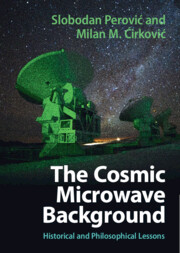Book contents
- The Cosmic Microwave Background
- The Cosmic Microwave Background
- Copyright page
- Epigraph
- Contents
- Acknowledgments
- Introduction
- Part I Physical cosmology: A brief introduction
- Part II Discovery of the CMB and current cosmological orthodoxy
- 4 Discovery of the CMB
- 5 CMB phenomenology
- 6 Standard “textbook” history and its shortcomings
- 7 Emergence of precision cosmology
- Part III What constitutes an unorthodoxy? An epistemological framework of cosmology
- Part IV Moderate unorthodoxies: The CMB with the Big Bang
- Part V Radical unorthodoxies: The CMB without the Big Bang
- Part VI Formation of the orthodoxy and the alternatives: Epistemological lessons
- Part VII Other philosophically relevant aspects of the CMB
- Book part
- Notes
- References
- Index
4 - Discovery of the CMB
from Part II - Discovery of the CMB and current cosmological orthodoxy
Published online by Cambridge University Press: aN Invalid Date NaN
- The Cosmic Microwave Background
- The Cosmic Microwave Background
- Copyright page
- Epigraph
- Contents
- Acknowledgments
- Introduction
- Part I Physical cosmology: A brief introduction
- Part II Discovery of the CMB and current cosmological orthodoxy
- 4 Discovery of the CMB
- 5 CMB phenomenology
- 6 Standard “textbook” history and its shortcomings
- 7 Emergence of precision cosmology
- Part III What constitutes an unorthodoxy? An epistemological framework of cosmology
- Part IV Moderate unorthodoxies: The CMB with the Big Bang
- Part V Radical unorthodoxies: The CMB without the Big Bang
- Part VI Formation of the orthodoxy and the alternatives: Epistemological lessons
- Part VII Other philosophically relevant aspects of the CMB
- Book part
- Notes
- References
- Index
Summary
As this chapter explains, the first systematic predictions of the cosmic microwave background radiation were put forward by three independent groups of early proponents of the Big Bang Model: Gamow and his students, Doroshkevich and Novikov, and Dicke and his collaborators. The theoretical inferences that a uniform background radiation should be present came to fruition in 1965 with a serendipitous discovery by Penzias and Wilson. The prediction was that after the period of electrons and nuclei finally combining into atoms was finished some 400,000 years ago, the omnipresent radiation (cosmological photons) would scatter off the atoms and continue traveling until they reach us, while cooling down to the tens of kelvin from the initial 3000 kelvin. Various early predictions differed and were off from the measured 3 kelvin, due to some theoretical unknowns at the time. Yet the first measurement likely occurred before World War II with the measuring of the excitation of cyanogen molecules in a distant nebula, a fact pointed out by Fred Hoyle, the main critic of the Big Bang model (who also coined the phrase Big Bang, albeit pejoratively). The early predictions were only the first segment of a long convergence to the Hot Big Bang model as a standard model of cosmology.
Keywords
- Type
- Chapter
- Information
- The Cosmic Microwave BackgroundHistorical and Philosophical Lessons, pp. 19 - 23Publisher: Cambridge University PressPrint publication year: 2024



